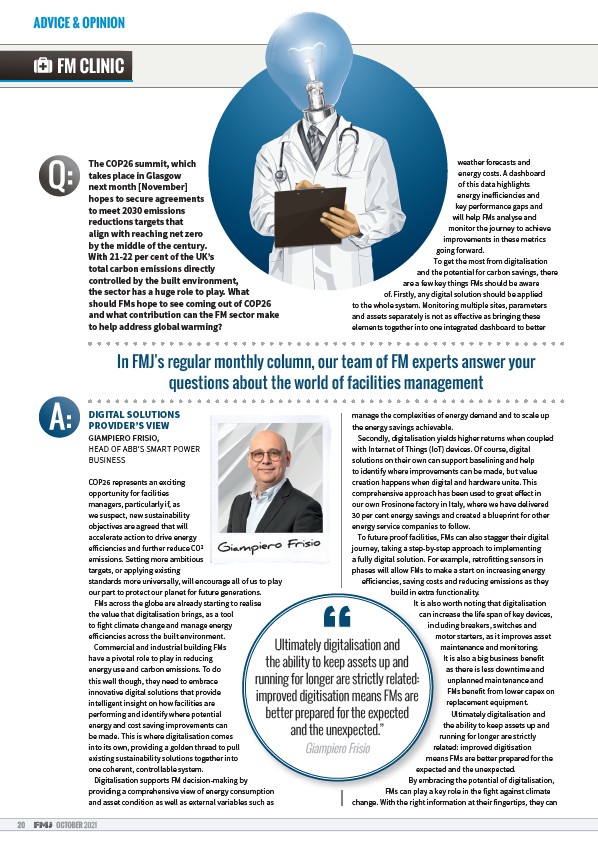
In FMJ's regular monthly column, our team of FM experts answer your
questions about the world of facilities management
DIGITAL SOLUTIONS
PROVIDER’S VIEW
GIAMPIERO FRISIO,
HEAD OF ABB’S SMART POWER
BUSINESS
COP26 represents an exciting
opportunity for facilities
managers, particularly if, as
we suspect, new sustainability
objectives are agreed that will
accelerate action to drive energy
e iciencies and further reduce CO€
emissions. Setting more ambitious
targets, or applying existing
standards more universally, will encourage all of us to play
our part to protect our planet for future generations.
FMs across the globe are already starting to realise
the value that digitalisation brings, as a tool
to fight climate change and manage energy
e iciencies across the built environment.
Commercial and industrial building FMs
have a pivotal role to play in reducing
energy use and carbon emissions. To do
this well though, they need to embrace
innovative digital solutions that provide
intelligent insight on how facilities are
performing and identify where potential
energy and cost saving improvements can
be made. This is where digitalisation comes
into its own, providing a golden thread to pull
existing sustainability solutions together into
one coherent, controllable system.
Digitalisation supports FM decision-making by
providing a comprehensive view of energy consumption
and asset condition as well as external variables such as
20 OCTOBER 2021
weather forecasts and
energy costs. A dashboard
of this data highlights
energy ine iciencies and
key performance gaps and
will help FMs analyse and
monitor the journey to achieve
improvements in these metrics
going forward.
To get the most from digitalisation
and the potential for carbon savings, there
are a few key things FMs should be aware
of. Firstly, any digital solution should be applied
to the whole system. Monitoring multiple sites, parameters
and assets separately is not as e ective as bringing these
elements together into one integrated dashboard to better
manage the complexities of energy demand and to scale up
the energy savings achievable.
Secondly, digitalisation yields higher returns when coupled
with Internet of Things (IoT) devices. Of course, digital
solutions on their own can support baselining and help
to identify where improvements can be made, but value
creation happens when digital and hardware unite. This
comprehensive approach has been used to great e ect in
our own Frosinone factory in Italy, where we have delivered
30 per cent energy savings and created a blueprint for other
energy service companies to follow.
To future proof facilities, FMs can also stagger their digital
journey, taking a step-by-step approach to implementing
a fully digital solution. For example, retrofitting sensors in
phases will allow FMs to make a start on increasing energy
e iciencies, saving costs and reducing emissions as they
build in extra functionality.
It is also worth noting that digitalisation
can increase the life span of key devices,
including breakers, switches and
motor starters, as it improves asset
maintenance and monitoring.
It is also a big business benefit
as there is less downtime and
unplanned maintenance and
FMs benefit from lower capex on
replacement equipment.
Ultimately digitalisation and
the ability to keep assets up and
running for longer are strictly
related: improved digitisation
means FMs are better prepared for the
expected and the unexpected.
By embracing the potential of digitalisation,
FMs can play a key role in the fight against climate
change. With the right information at their fingertips, they can
FM CLINIC
The COP26 summit, which
takes place in Glasgow
next month November
hopes to secure agreements
to meet 2030 emissions
reductions targets that
align with reaching net zero
by the middle of the century.
With 21-22 per cent of the UK’s
total carbon emissions directly
controlled by the built environment,
the sector has a huge role to play. What
should FMs hope to see coming out of COP26
and what contribution can the FM sector make
to help address global warming?
Giampiero Frisio
ADVICE & OPINION
Ultimately digitalisation and
the ability to keep assets up and
running for longer are strictly related:
improved digitisation means FMs are
better prepared for the expected
and the unexpected.”
Giampiero Frisio